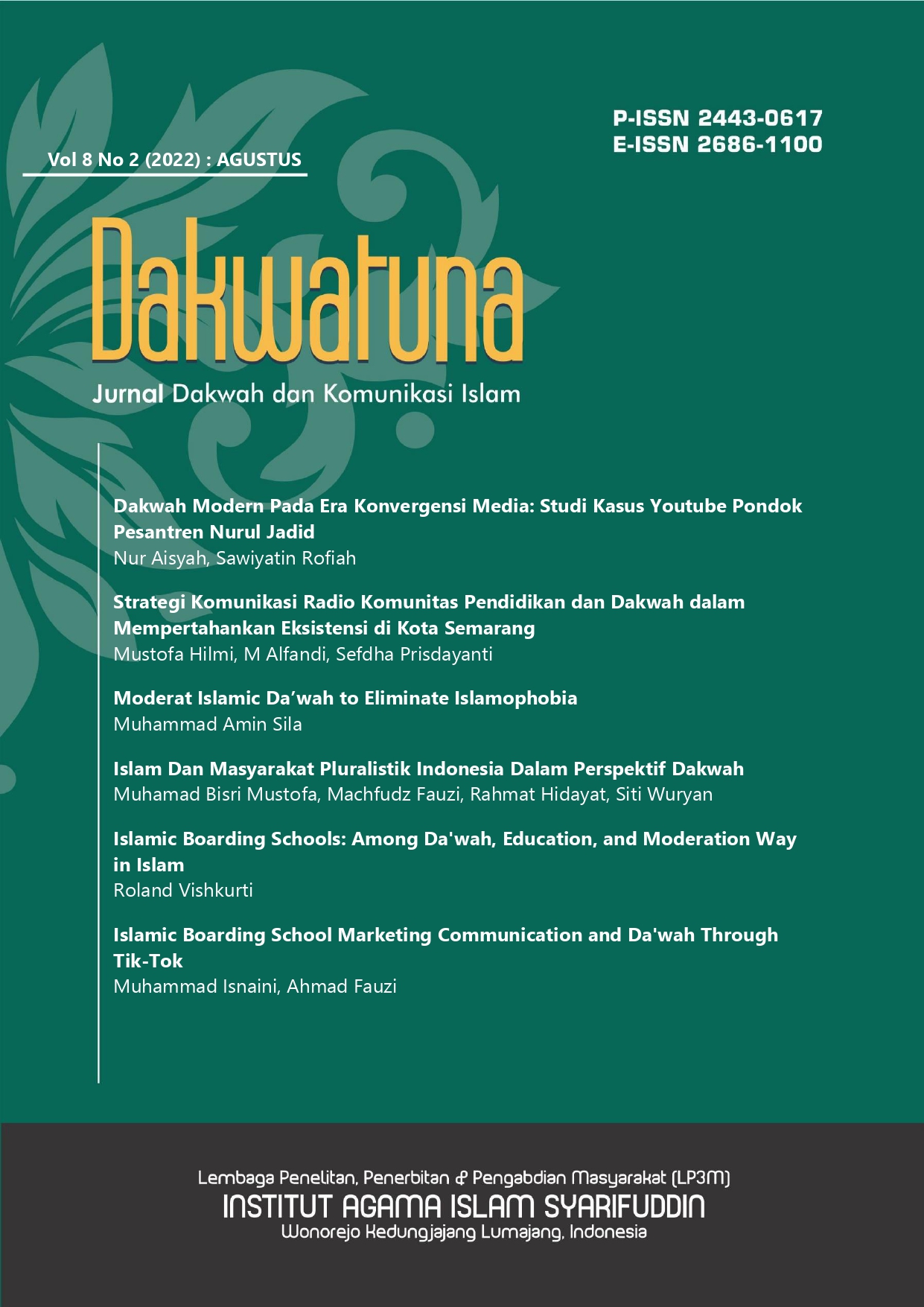Islamic Boarding School Marketing Communication and Da'wah Through Tik-Tok
DOI:
https://doi.org/10.54471/dakwatuna.v8i2.1919Keywords:
Da'wah, Marketing Communication, Islamic Boarding School, Tik-TokAbstract
Marketing communication is a means of informing, persuading, and reminding consumers directly or indirectly about the products and brands being sold. In the context of this research, marketing communication is carried out with regard to the service products offered by the Asy-Syarifiy Islamic boarding school. In particular, that is done through the Tik-Tok social media account. Because it is classified as an Islamic educational institution, in each stage of marketing communication, there are nuances of preaching that are delivered. Da'wah and marketing communications are the focus of research in this article. The Tik-Tok account analyzed is @Kingzadma which belongs to the boarding school caregiver. The purpose of this study is to describe the da'wah model and marketing communication strategy of the Asy-Syarifiy Islamic boarding school through social media Tik-Tok @Kingzadma. This study uses a qualitative method. Data collection techniques using interviews, observation and documentation. Based on the results of the research, it is known that the da'wah model and marketing communication strategy carried out by the Tik-Tok @Kingzadma account uses four elements, namely, entertainment, interaction, trendiness and customization. Da'wah and marketing communications are carried out through the exploration of these four elements. Entertainment is everything in the form of words, places, objects, behaviors that can be comfort or consolation for a difficult or sad heart. Interaction is a meeting between a person and another individual. Trendiness is the ability to browse trending content on Tik-Tok and adapt it to your own content. Customization is a presentation in a video or video display to make it more interesting.
Downloads
References
Diana, Z. F. (2021). Domestikasi Media Sosial dalam Aktivitas Dakwah di Kalangan Millenial. Dakwatuna: Jurnal Dakwah dan Komunikasi Islam, 8(1), 1-18.
Farid, A. (2019). Optimalisasi Media Sosial Pesantren untuk Membendung Konten Negatif di Dunia Maya. Dakwatuna: Jurnal Dakwah dan Komunikasi Islam, 5(1), 30-37.
Febriana, A. (2021). Pemanfaatan Tik-Tok Sebagai Media Dakwah:(Studi Kasus Ustad Syam, di akun@ syam_elmarusy). KOMUNIDA: Media Komunikasi dan Dakwah, 11(02), 180-194.
Hakim, F. N. R., Kamaludin, I., & Sujana, S. N. (2021). The New Da’wah Strategy among Millennial Generations through Tiktok During Pandemic. Islam Realitas: Journal of Islamic and Social Studies, 7(2), 167-180.
Ida, R. (2018). Etnografi virtual sebagai teknik pengumpulan data dan metode penelitian. The Journal of Society and Media, 2(2), 130-145.
Kim, A. J., & Ko, E. (2012). Do social media marketing activities enhance customer equity? An empirical study of luxury fashion brand. Journal of Business research, 65(10), 1480-1486.
Klug, D., Qin, Y., Evans, M., & Kaufman, G. (2021, June). Trick and please. A mixed-method study on user assumptions about the TikTok algorithm. In 13th ACM Web Science Conference 2021 (pp. 84-92).
Kotler, P. (1999). Marketing management: The millennium edition (Vol. 199). Upper Saddle River, NJ: Prentice Hall.
Moefad, A. M., Syaifuddin, S., & Sholichati, I. (2021). Digitizing Religion: Millenial Generation Da’wah Patterns on Social Media. Ilmu Dakwah: Academic Journal for Homiletic Studies, 15(2), 387-406.
Munir, M. (2021). Manajemen dakwah. Jakarta: Prenada Media.
Nasrullah, Rulli. (2017). Etnografi Virtual. Bandung: Simbiosa Rekatama Media
Nihayaty, A. I., & Rohmy, A. M. (2020). Pemanfaatan Media Sosial Komunitas Untuk Menghadapi Konten Islam Ekstrim Di Internet. Dakwatuna: Jurnal Dakwah dan Komunikasi Islam, 6(2), 213-227.
Purwanto, H., & Nuha, A. A. (2020). Post Dakwah di Era Cyber Culture. Dakwatuna: Jurnal Dakwah dan Komunikasi Islam, 6(2), 228-255.
Putri, A. R. (2021). Event Sebagai Media Branding Institusi. Dakwatuna: Jurnal Dakwah dan Komunikasi Islam, 7(1), 21-41.
Rachman, R. F. (2017). Menelaah riuh budaya masyarakat di dunia maya. Jurnal Studi Komunikasi, 1(2), 206-222.
Rachman, R. F. (2019). Optimalisasi Media Digital Berbasis Kemaslahatan Umat dalam Program Pahlawan Ekonomi Surabaya. IQTISHODUNA: Jurnal Ekonomi Islam, 8(2), 273-292.
Rohman, D. A. (2019). Komunikasi dakwah melalui media sosial. Tatar Pasundan: Jurnal Diklat Keagamaan, 13(2), 121-133.
Rohman, F. (2018). Strategi pemasaran Kelompok Bimbingan Ibadah Haji dan Umroh Al Mabrur Lumajang. Dakwatuna: Jurnal Dakwah dan Komunikasi Islam, 4(2), 197-230.
Rohmy, A. M., Suratman, T., & Nihayaty, A. I. (2021). UU ITE Dalam Perspektif Perkembangan Teknologi Informasi dan Komunikasi. Dakwatuna: Jurnal Dakwah dan Komunikasi Islam, 7(2), 309-339.
Selwyn, N. (2015). The discursive construction of education in the digital age. In R. H. Jones, A. Chik, & C. A. Hafner (Eds.), Discourse Analysis and Digital Practices. London: Routledge.
Shimp, Terence A. (2003). Periklanan Promosi & Aspek Tambahan Komunikasi
Pemasaran Terpadu, Jilid I. Jakarta: Erlangga
Verolyna, D., & Syaputri, I. K. (2021). Cyber Dakwah: Plus Minus Penyiaran Islam Pada Era Disruptif. Jurnal Dakwah dan Komunikasi, 6(1), 23-38.
Zhang, Z. (2021). Infrastructuralization of Tik Tok: Transformation, power relationships, and platformization of video entertainment in China. Media, Culture & Society, 43(2), 219-236.
Zhao, Z. (2021). Analysis on the “Douyin (Tiktok) Mania†Phenomenon Based on Recommendation Algorithms. In E3S Web of Conferences (Vol. 235, p. 03029). EDP Sciences.
Downloads
Published
Issue
Section
License
Seluruh materi yang terdapat dalam situs ini dilindungi oleh undang-undang. Dilarang mengutip sebagian atau seluruh isi situs web ini untuk keperluan komersil tanpa persetujuan dewan penyunting jurnal ini.
Apabila anda menemukan satu atau beberapa artikel yang terdapat dalam DAKWATUNA yang melanggar atau berpotensi melanggar hak cipta yang anda miliki, silahkan laporkan kepada kami, melalui email pada Priciple Contact.
Aspek legal formal terhadap akses setiap informasi dan artikel yang tercantum dalam situs jurnal ini mengacu pada ketentuan lisensi Creative Commons Atribusi-ShareAlike (CC BY-SA).
Semua Informasi yang terdapat di DAKWATUNAÂ bersifat akademik. DAKWATUNAÂ tidak bertanggung jawab terhadap kerugian yang terjadi karana penyalahgunaan informasi dari situs ini.


















